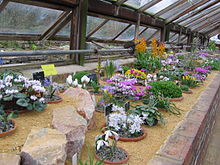Alpine house

An Alpine House , also known as alpine house called is usually an unheated glasshouse culture sensitive plant species. Often it is sunk into the ground. The advantage of this is that the warming progresses slowly during the summer, whereas the cooling is less in the winter.
It is used to cultivate plant species that are sensitive to severe frosts, but also need protection from too much rainfall, especially in winter. For many of these species, the conditions in the tropical house are not suitable because of the heat there, so that a culture in the alpine house is also used in botanical gardens . In addition to mountain plants, this also applies to Mediterranean plants and plant species from comparable climatic zones that are native to America and Asia.
Structural execution
The alpine house is usually designed as an unheatable glass house that is often sunk into the ground. The Alpine House in the Botanical Garden of the University of Innsbruck , for example, is 14 meters long, 5 meters wide and 3.6 meters high up to the ridge. The foundation is sunk about a meter into the ground. A partition inside offers the possibility of heating one area and leaving another unheated. Side vents and, in particular, vents around the roof edges ensure optimal air circulation . To avoid leaf burns and excessive heating during the summer, alpine houses often have a shading device. Inside the alpine house is mostly equipped with raised beds that are filled with sand . This is where the plants grown in clay pots are sunk. The sand insert reduces the effort involved in pouring. This also usually prevents frost damage in the root area during winter.
advantages
The advantage of sinking the earth is that warming progresses slowly during summer, while cooling is less in winter. Especially plants that are native to the high mountains are protected against severe frosts by a permanent snow cover during the cold season. In summer, cooling off at night in the mountains offers relaxation from the high daytime temperatures. Summer rainfall in the mountains is also often less intense. These species find it difficult to adapt to the conditions of a culture in regions of the lowlands, which are characterized by alternating frosts, severe frosts without a snow cover, hot summer nights and long-lasting rainfall. Persistent precipitation favors putrefactive germs at lower altitudes that do not occur in the mountains. A culture in the Alpinenhaus largely compensates for these differences.
supporting documents
- ↑ a b c d University of Innsbruck: Alpinhaus
- ↑ Eckehart J. Jäger, Friedrich Ebel, Peter Hanelt, Gerd K. Müller (eds.): Exkursionsflora von Deutschland . Founded by Werner Rothmaler. tape 5 : Herbaceous ornamental and useful plants . Springer, Spektrum Akademischer Verlag, Berlin / Heidelberg 2008, ISBN 978-3-8274-0918-8 , pp. 828 .
- ↑ a b Alpinenhaus in the Botanical Garden St. Gallen, Switzerland, stadt.sg.ch, accessed October 13, 2019.
- ↑ a b Dirk Mann: Perennial rarities: cultivating and collecting garden jewels , Franckh-Kosmos-Verlag; 1st edition January 2018, p. 92 f. ISBN 978-3-440-15632-2 .
Web links
- K. Klaintahe: Alpinenhaus - Botanical Garden of the University of Tübingen - Tübingen on YouTube , September 27, 2018, accessed on September 13, 2019 (video, 2:38 min.).
